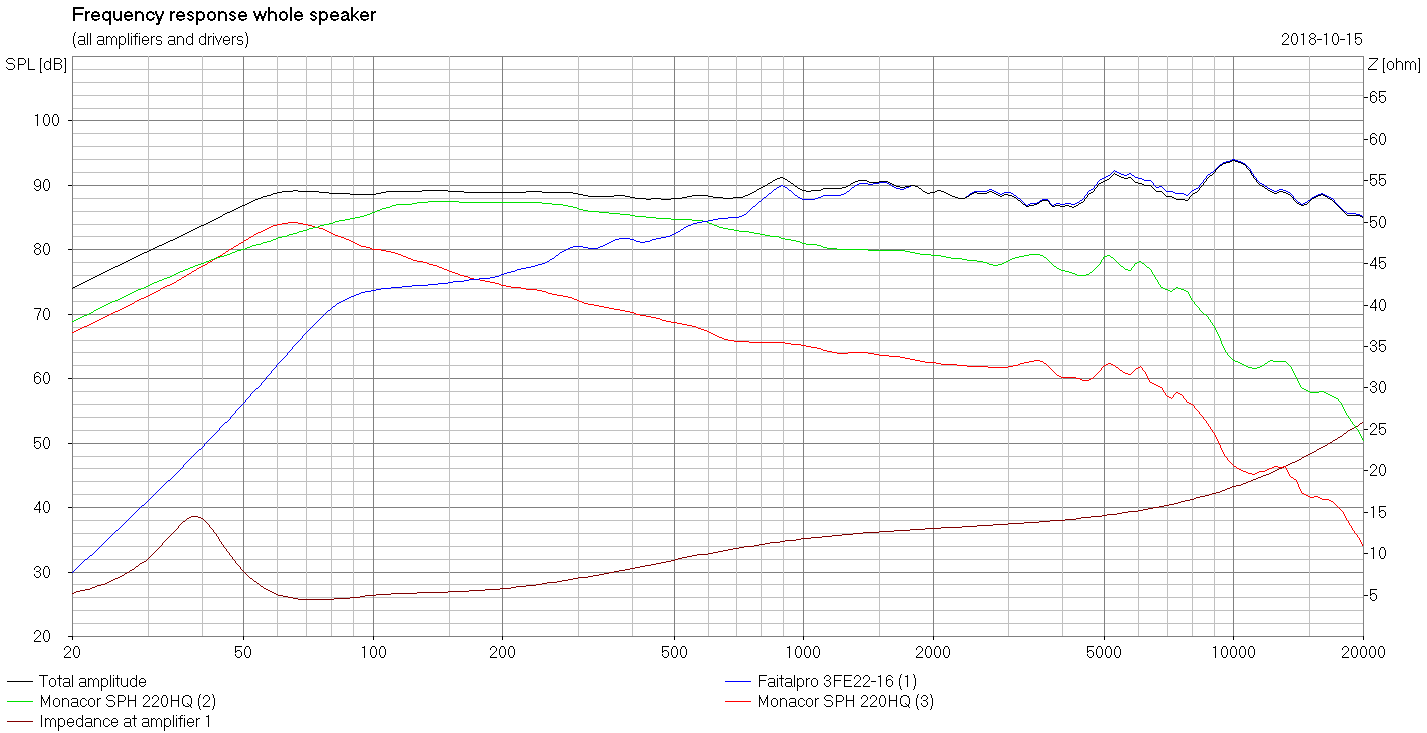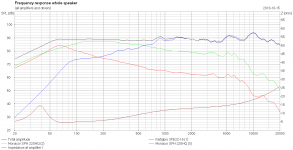I realized I wrote that I was aiming for a Qts of 0.6 in my last post, of course I meant Qtc.
Anyhow, I suspected the bump the filters generated around resonance frequency had something to do with the impedance peak. So I looked into it and found out about Impedance Equalizer Circuits. Haven't heard of them until now. Currently playing around with 6.5"woofers, and a resistor with a 1000µf capacitor in parallel with a woofer eliminates the impedance peak.
Now my 1st order filters and my cascaded woofers work just as I want on paper.
But I need to know. Why is this considered infeasible? It looks to me like I might be able to extend a flat frequency response a good bit further down with one bass extending speaker. A sealed box with 6.5" midwoofers being quite flat down to 40Hz before even starting to roll off isn't bad in my opinion. Seems like I can do low frequencies with good transients and avoid flabby subwoofers in ported boxes. Or am I missing something?
I realize that XSim doesn't take the impedance into consideration properly. Impedance Equalization works on the Impedance curve, but it doesn't affect frequency response at all. Basta works well. But since the impedance equalization is in parallel with the speakers, and Basta can't handle parallel speakers with different filters, I still can't get the final filter in Basta as easily as I hoped. I can't get the impedance equalization and the speakers in parallel at the same time. But I can do a decent approximation of which capacitor to use at least.
Right now I have three questions. Why is this considered infeasible or not worth it? Are there any drawbacks with a simple equalization circuit (resistor and cap in parallel with speaker) I should now about? Which program is recommended to handle filter design and box calculations at the same time?
EDIT:
Equipped with new search terms I found this:
Extending woofer f3 point?
That build looks a lot like what I was considering building. The extra woofer extending the bass down to 36Hz in a sealed enclosure, made possible with impedance equalization. I was considering a curved baffle. And the only thing keeping me from adding an extra mid/high and maybe a dedicated tweeter and go open baffle is that I don't want to experiment outside my competence at to many fronts at the same time. Too many things that can go wrong in the same project will certainly mean failure. This encourages me alot.
Anyhow, I suspected the bump the filters generated around resonance frequency had something to do with the impedance peak. So I looked into it and found out about Impedance Equalizer Circuits. Haven't heard of them until now. Currently playing around with 6.5"woofers, and a resistor with a 1000µf capacitor in parallel with a woofer eliminates the impedance peak.
Now my 1st order filters and my cascaded woofers work just as I want on paper.
But I need to know. Why is this considered infeasible? It looks to me like I might be able to extend a flat frequency response a good bit further down with one bass extending speaker. A sealed box with 6.5" midwoofers being quite flat down to 40Hz before even starting to roll off isn't bad in my opinion. Seems like I can do low frequencies with good transients and avoid flabby subwoofers in ported boxes. Or am I missing something?
I realize that XSim doesn't take the impedance into consideration properly. Impedance Equalization works on the Impedance curve, but it doesn't affect frequency response at all. Basta works well. But since the impedance equalization is in parallel with the speakers, and Basta can't handle parallel speakers with different filters, I still can't get the final filter in Basta as easily as I hoped. I can't get the impedance equalization and the speakers in parallel at the same time. But I can do a decent approximation of which capacitor to use at least.
Right now I have three questions. Why is this considered infeasible or not worth it? Are there any drawbacks with a simple equalization circuit (resistor and cap in parallel with speaker) I should now about? Which program is recommended to handle filter design and box calculations at the same time?
EDIT:
Equipped with new search terms I found this:
Extending woofer f3 point?
That build looks a lot like what I was considering building. The extra woofer extending the bass down to 36Hz in a sealed enclosure, made possible with impedance equalization. I was considering a curved baffle. And the only thing keeping me from adding an extra mid/high and maybe a dedicated tweeter and go open baffle is that I don't want to experiment outside my competence at to many fronts at the same time. Too many things that can go wrong in the same project will certainly mean failure. This encourages me alot.
Last edited:
Given that we are discussing this in the Full Range forum I think you should reconsider your strategy here. Your plans are getting very complicated with multiple added drivers. My advice would be to build one of the proven full range designs recommended by Dave. Once you get familiar with the pros and cons of Full Range you can then decide what supplements, if any, you need in the bass range. IME the best solution for deep basss in a lot of rooms is 2 powered subs carefully placed and adjusted by ear to get the bass impact and extension you prefer. I spent years getting to that point in my room. All rooms and tastes vary and there is no guaranteed recipe for success.
Given that we are discussing this in the Full Range forum I think you should reconsider your strategy here. Your plans are getting very complicated with multiple added drivers. My advice would be to build one of the proven full range designs recommended by Dave. Once you get familiar with the pros and cons of Full Range you can then decide what supplements, if any, you need in the bass range. IME the best solution for deep basss in a lot of rooms is 2 powered subs carefully placed and adjusted by ear to get the bass impact and extension you prefer. I spent years getting to that point in my room. All rooms and tastes vary and there is no guaranteed recipe for success.
Nevermind which forum I posted in. I will not change my plans just because I placed the thread in the full range forum.
And about building an existing build. I don't build speakers because I want something traditional. I build my own because I have certain notions of what I want to achieve.
Anyhow, my plan is to build two tops first consisting of a single 3FE22 per enclosure to try them out a bit. Then I'll add a filter and a woofer box @ 0.5 Qtc with a single woofer. If I am satisfied with the characteristics of the driver then I'll add another one as a helper woofer and thus raise the Qtc to ~0.55. Then I'll experiment with the impedance equalizing circuit and low pass filter for the helper woofer and see if I can get that to work.
I figure you gave up on me?
Anyway. I gave up on the second woofer idea. The program I used didn't handle multiple drivers with different crossovers very good. The impedance peak messed up the XO and gave me sensitivity peak at that frequency. To flatten the peak out I would need to add parts to the filter I didn't want and it was costly.
I then migrated my project to boxsim which is a much better program. It managed multiple drivers correctly. And when the drivers was in parallell there the peak was evened out enough for the bass extender to work again. So I revived the Idea.
So, what do you think of the attached graph? It includes calculations on the box with baffle step. The woofers and the 3FE22 I based my calculations on have roughly the same sensitivity. So I couldn't just counter the baffle step by matching XO frequency. For that I would need a louder woofer or two of them. So instead I switched to the 16Ω version of the 3FE22. Then I subtracted 3dB from the measurements since they where at 1W/1m, and I wanted 2.83V/1m. Was this correct?
The 8Ω woofers and a 16Ω fullrange together evens out the impedance peaks pretty well. So the filter is simple. 1st order between 3FE22 and the woofer, and 1st order low pass on the bass extending woofer. No baffle step correction, no impedance equalization circuit ot anything else. I did however need to mirror the polarity of the fullrange despite 1st order XO.
As you see the impedance rises a bit in this graph, so one might think sensitivity would be skewed accordingly. But as I said, I have lowered the fullrange 3dB to get a good picture of how it performs at the same voltage as the woofers.

Anyway. I gave up on the second woofer idea. The program I used didn't handle multiple drivers with different crossovers very good. The impedance peak messed up the XO and gave me sensitivity peak at that frequency. To flatten the peak out I would need to add parts to the filter I didn't want and it was costly.
I then migrated my project to boxsim which is a much better program. It managed multiple drivers correctly. And when the drivers was in parallell there the peak was evened out enough for the bass extender to work again. So I revived the Idea.
So, what do you think of the attached graph? It includes calculations on the box with baffle step. The woofers and the 3FE22 I based my calculations on have roughly the same sensitivity. So I couldn't just counter the baffle step by matching XO frequency. For that I would need a louder woofer or two of them. So instead I switched to the 16Ω version of the 3FE22. Then I subtracted 3dB from the measurements since they where at 1W/1m, and I wanted 2.83V/1m. Was this correct?
The 8Ω woofers and a 16Ω fullrange together evens out the impedance peaks pretty well. So the filter is simple. 1st order between 3FE22 and the woofer, and 1st order low pass on the bass extending woofer. No baffle step correction, no impedance equalization circuit ot anything else. I did however need to mirror the polarity of the fullrange despite 1st order XO.
As you see the impedance rises a bit in this graph, so one might think sensitivity would be skewed accordingly. But as I said, I have lowered the fullrange 3dB to get a good picture of how it performs at the same voltage as the woofers.
Attachments
- Status
- This old topic is closed. If you want to reopen this topic, contact a moderator using the "Report Post" button.
